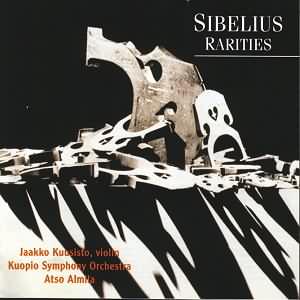
Castanets? Sibelius? Yes this is the extraordinary
colouration Sibelius employs in parts of his early 1891 work Scene
de ballet. It is something of an early valse
triste with a disconcerting distancing of the waltz for this is
music for a morality play - perhaps remorse brought on by reckless carousing?
It has splashes of colour from castanets and triangle but the intensity
of Berlioz's Symphonie Fantastique seems to have been a model
for this rather demonic bacchanalian piece.
The Scene de ballet is the first of 12 short
rarely-heard Sibelius pieces. They are interesting but hardly earth
shattering or exciting discoveries. Two overtures follow the first in
E Major and the other in A minor. The Overture in E Major, subtitled
Wolf-hunting in Siberia, (again from 1891) resembling a Finnish sleigh
song in melody and rhythm, is not very original; it is influenced by
Bruckner and Wagner but anticipates Kullervo and Leminkäinen.
The A minor Overture (1902) has more charm and joviality and
it owes something to Mendelssohn while anticipating Sibelius's own Third
Symphony.
Cassazione op 6 (1904) was meant to
be a light work for outdoor entertainment but its ghostly episodes must
have sent a shiver through its listeners. In Memoriam
(1909/10) is more impressive - an imposing work, an expression of deep
personal pain or death; it was written while the composer was in Berlin
studying Mahler's Fifth Symphony. The doleful Wedding March (1911)
would not have impressed many brides; but it was written as part of
his incidental music for a play called The Language of Birds.
The orchestration is interesting no bassoons or horns and only one oboe
but with a wealth of percussion. The music has a chamber-music feel
but is rhythmically, melodically and thematically amorphous although
one is aware of bird calls.
Song of the people of Uusimaa (1912)
is a noble and quite memorable semi-patriotic piece.
Serenade No. 1 in D Major (1912) for violin
and orchestra is lyrical yet it has a darkly passionate force with the
strings (as the notes put it) 'painting shadows of the internal turmoil
of the soul'. The accompanying Serenade No 2 in G Minor (1913)
opens with a sweet melody but again its darkened by the C sharp-G tritone.
This Serenade is reminiscent of the finale of the Violin Concerto and
the ride section of Night Ride and Sunrise. Violinist Kuusisto
is darkly passionate in both pieces.
The programme ends with three short pieces: a dejected
Berceuse (the booklet describes it as happy!); a defiant
Polonaise (1916) tinged with melancholy; and, finally,
a bright marching song, Jääkärimarssi (March
of the Jaegers) (1917).
The Kuopi Symphony Orchestra play with commitment.
For Sibelius completists

